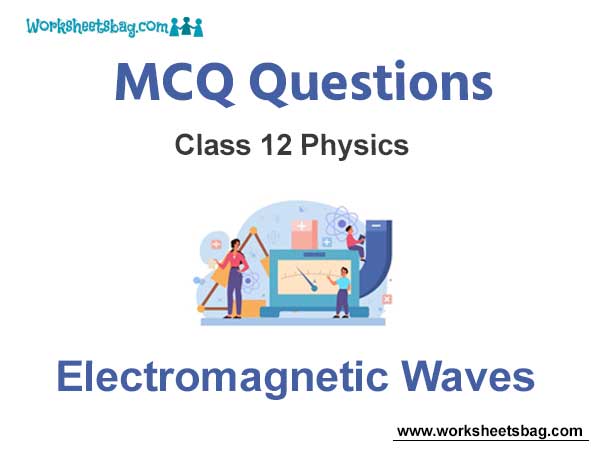Please refer to Electromagnetic Waves MCQ Questions Class 12 Physics below. These MCQ questions for Class 12 Physics with answers have been designed as per the latest NCERT, CBSE books, and syllabus issued for the current academic year. These objective questions for Electromagnetic Waves will help you to prepare for the exams and get more marks.
Electromagnetic Waves MCQ Questions Class 12 Physics
Please see solved MCQ Questions for Electromagnetic Waves in Class 12 Physics. All questions and answers have been prepared by expert faculty of standard 12 based on the latest examination guidelines.
MCQ Questions Class 12 Physics Electromagnetic Waves
Question. A parallel plate capacitor of capacitance 20 μF is being charged by a voltage source whose potential is changing at the rate of 3 V/s. The conduction current through the connecting wires, and the displacement current through the plates of the capacitor, would be, respectively
(a) zero, zero
(b) zero, 60 μA
(c) 60 μA, 60 μA
(d) 60 μA, zero
Answer
C
Question. A 100 Ω resistance and a capacitor of 100 Ω reactance are connected in series across a 220 V source. When the capacitor is 50% charged, the peak value of the displacement current is
(a) 2.2 A
(b) 11 A
(c) 4.4 A
(d) 11 √2 A
Answer
A
Question. For a transparent medium relative permeability and permittivity, μr and er are 1.0 and 1.44 respectively. The velocity of light in this medium would be
(a) 2.5 × 108 m/s
(b) 3 × 108 m/s
(c) 2.08 × 108 m/s
(d) 4.32 × 108 m/s
Answer
A
Question. An electromagnetic wave of frequency u = 3.0 MHz passes from vacuum into a dielectric medium with relative permittivity e = 4.0. Then
(a) Wavelength is doubled and frequency becomes half.
(b) Wavelength is halved and frequency remains unchanged.
(c) Wavelength and frequency both remain unchanged.
(d) Wavelength is doubled and frequency unchanged
Answer
B
Question. Which of the following statement is false for the properties of electromagnetic waves ?
(a) Both electric and magnetic field vectors attain the maxima and minima at the same place and same time.
(b) The energy in electromagnetic wave is divided equally between electric and magnetic vectors.
(c) Both electric and magnetic field vectors are parallel to each other and perpendicular to the direction of propagation of wave.
(d) These waves do not require any material medium for propagation
Answer
C
Question. An em wave is propagating in a medium with a velocity v→ = v ^i . The instantaneous oscillating electric field of this em wave is along +y axis. Then the direction of oscillating magnetic field of the em wave will be along
(a) –z direction
(b) +z direction
(c) –y direction
(d) –x direction
Answer
B
Question. Light with an average flux of 20 W/cm2 falls on a non-reflecting surface at normal incidence having surface area 20 cm2. The energy received by the surface during time span of 1 minute is
(a) 10 × 103 J
(b) 12 × 103 J
(c) 24 × 103 J
(d) 48 × 103 J
Answer
C
Question. The ratio of contributions made by the electric field and magnetic field components to the intensity of an electromagnetic wave is (c = speed of electromagnetic waves)
(a) c : 1
(b) 1 : 1
(c) 1 : c
(d) 1 : c2
Answer
B
Question. In an electromagnetic wave in free space the root mean square value of the electric field is Erms = 6 V m–1. The peak value of the magnetic field is
(a) 2.83 × 10–8 T
(b) 0.70 × 10–8 T
(c) 4.23 × 10–8 T
(d) 1.41 × 10–8 T
Answer
A
Question. Light with an energy flux of 25 × 104 W m–2 falls on a perfectly reflecting surface at normal incidence. If the surface area is 15 cm2, the average force exerted on the surface is
(a) 1.25 × 10–6 N
(b) 2.50 × 10–6 N
(c) 1.20 × 10–6 N
(d) 3.0 × 10–6 N
Answer
B
Question. The electric field of an electromagnetic wave in free space is given by E→ = 10 cos (107 t + kx)jˆ V /m , where t and x are in seconds and metres respectively. It can be inferred that
(1) the wavelength λ is 188.4 m.
(2) the wave number k is 0.33 rad/m.
(3) the wave amplitude is 10 V/m.
(4) the wave is propagating along +x direction.
Which one of the following pairs of statements is correct?
(a) (3) and (4)
(b) (1) and (2)
(c) (2) and (3)
(d) (1) and (3)
Answer
B
Question. The electric field associated with an em wave in vacuum is given by [E = i ^ 40 cos (kz – 6 × 108t)]; where E, z and t are in volt/m, meter and seconds respectively. The value of wave vector k is
(a) 2 m–1
(b) 0.5 m–1
(c) 6 m–1
(d) 3 m–1
Answer
A
Question. The ratio of amplitude of magnetic field to the amplitude of electric field for an electromagnetic wave propagating in vacuum is equal to
(a) the speed of light in vacuum
(b) reciprocal of speed of light in vacuum
(c) the ratio of magnetic permeability to the electric susceptibility of vacuum
(d) unity.
Answer
B
Question. The electric and the magnetic field, associated with an e.m. wave, propagating along the +z-axis, can be represented by

Answer
A
Question. The electric field part of an electromagnetic wave in a medium is represented by Ex = 0;

Ez = 0. The wave is
(a) moving along x direction with frequency 106 Hz and wavelength 100 m
(b) moving along x direction with frequency 106 Hz and wavelength 200 m
(c) moving along –x direction with frequency 106 Hz and wavelength 200 m
(d) moving along y direction with frequency 2π × 106 Hz and wavelength 200 m.
Answer
B
Question. The velocity of electromagnetic radiation in a medium of permittivity ∈0 and permeability μ0 is given by

Answer
A
Question. The frequency of electromagnetic wave, which best suited to observe a particle of radius 3 × 10–4 cm is of the order of
(a) 1015
(b) 1014
(c) 1013
(d) 1012
Answer
B
Question. Out of the following options which one can be used to produce a propagating electromagnetic wave ?
(a) A chargeless particle
(b) An accelerating charge
(c) A charge moving at constant velocity
(d) A stationary charge
Answer
B
Question. The energy of the em waves is of the order of 15 keV. To which part of the spectrum does it belong?
(a) Ultraviolet rays
(b) g-rays
(c) X-rays
(d) Infra-red rays
Answer
C
Question. The electric and magnetic field of an electromagnetic wave are
(a) in opposite phase and perpendicular to each other
(b) in opposite phase and parallel to each other
(c) in phase and perpendicular to each other
(d) in phase and parallel to each other.
Answer
C
Question. The velocity of electromagnetic wave is parallel to
(a) B→ × E→
(b) E→ × B→
(c) E→
(d) B→
Answer
B
Question. If ∈0 and μ0 are the electric permittivity and magnetic permeability in a free space, e and m are the corresponding quantities in medium, the index of refraction of the medium is

Answer
B
Question. We consider the radiation emitted by the human body. Which one of the following statements is true?
(a) The radiation emitted is in the infrared region.
(b) The radiation is emitted only during the day.
(c) The radiation is emitted during the summers and absorbed during the winters.
(d) The radiation emitted lies in the ultraviolet region and hence is not visible.
Answer
A
Question. Which of the following electromagnetic radiations have the longest wavelength ?
(a) X-rays
(b) Υ-rays
(c) Microwaves
(d) Radiowaves
Answer
D
Question. Which of the following rays are not electromagnetic waves ?
(a) X-rays
(b) Υ-rays
(c) β-rays
(d) heat rays
Answer
C
Question. The condition under which a microwave oven heats up a food item containing water molecules most efficiently is
(a) microwaves are heat waves, so always produce heating
(b) infra-red waves produce heating in a microwave oven
(c) the frequency of the microwaves must match the resonant frequency of the water molecules
(d) the frequency of the microwaves has no relation with natural frequency of water molecules.
Answer
C
Question. Wavelength of light of frequency 100 Hz is
(a) 4 × 106 m
(b) 3 × 106 m
(c) 2 × 106 m
(d) 5 × 10–5 m
Answer
B
Question. The decreasing order of wavelength of infrared, microwave, ultraviolet and gamma rays is
(a) microwave, infrared, ultraviolet, gamma rays
(b) gamma rays, ultraviolet, infrared, microwaves
(c) microwaves, gamma rays, infrared, ultraviolet
(d) infrared, microwave, ultraviolet, gamma rays
Answer
A
Question. If λv, lx and λm represent the wavelengths of visible light, X-rays and microwaves respectively, then
(a) λm > λx > λv
(b) λm > λv > λx
(c) λv > λx > λm
(d) λv > λm > λx.
Answer
B
Question. What is the cause of Green house effect?
(a) Infra-red rays
(b) Ultra violet rays
(c) X-rays
(d) Radio waves
Answer
A
Question. A signal emitted by an antenna from a certain point can be received at another point of the surface in the form of
(a) sky wave
(b) ground wave
(c) sea wave
(d) both (a) and (b)
Answer
D
Question. Biological importance of ozone layer is
(a) it stops ultraviolet rays
(b) ozone layer reduces green house effect
(c) ozone layer reflects radio waves
(d) ozone layer controls O2/H2 ratio in atmosphere.
Answer
A
Question. The frequency order for g-rays (B), X-rays (A),UV rays (C) is
(a) B > A > C
(b) A > B > C
(c) C > B > A
(d) A > C > B.
Answer
A
Question. Ozone layer blocks the radiations of wavelength
(a) more than 3 × 10–7 m
(b) equal to 3 × 10–7 m
(c) less than 3 × 10–7 m
(d) all of these
Answer
D
Question. The structure of solids is investigated by using
(a) cosmic rays
(b) X-rays
(c) Υ-rays
(d) infra-red radiations
Answer
B
Question. Which of the following electromagnetic radiations have the smaller wavelength?
(a) X-rays
(b) Υ-rays
(c) UV waves
(d) microwaves
Answer
B

